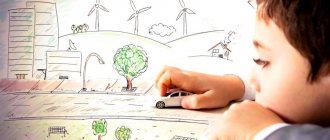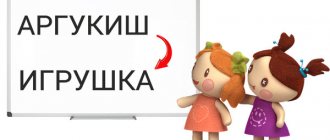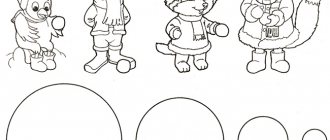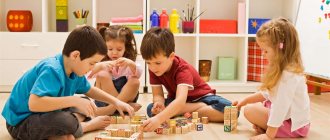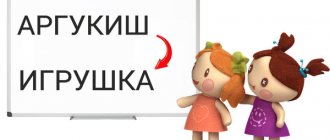Basic mnemonic devices
One of the most famous mnemonic devices is the acrostic poem. It is a poem or phrase where the first letters of each word or line form the key information to be remembered.
Since childhood, we have been familiar with the simple phrase “Every Hunter Wants to Know Where the Pheasant Sits.” This is how we remembered what colors the rainbow consists of and in what order they are located.
My grandmother taught me to easily remember the number of days in each month using my knuckles. And this is also mnemonics.
There are other interesting ways to remember. Let's start with basic techniques for adults.
Alphanumeric code
This method will help you remember your phone number, car number, house number, date of birth or any other number. Its essence is that we need to replace the numbers with the letters with which the names of the numbers begin.
See:
- 0 – zero – N;
- 1 – times – P;
- 2 – two – D;
- 3 – three – T;
- 4 – four – H;
- 5 – five – P;
- 6 – six – Ш;
- 7 – seven – C;
- 8 – eight – B;
- 9 – a lot – M (since we already have D under the number 2, nine is usually denoted by the word “many” and the letter M).
To make it easier to convert numbers into alphabetic codes, you need to learn these notations like a multiplication table. Then the encoding will pop up in your head automatically.
Let's try to encrypt the date of birth in this way. For example, December 25th.
The rule is this: the first number in the code is the first consonant letter in the word, the second number is the second consonant letter of this word. We will encrypt the next two digits into the second word using a similar principle.
So, we need to come up with the first word with the letters D and P. For example, DePo. The second word should contain the letters R and D. Let it be the word “Radio”. The result was a bunch of “DePo Radio”. If you need a more meaningful phrase to remember, you can make up the phrase “Radio played at DePauw.”
More than 100 cool lessons, tests and exercises for brain development
Start developing
I think you understand the principle.
Associations
Consider the “Hanger” technique. Its essence is that in order to remember a word, name, digital value, we need to attach an association to it.
For example, in order to easily remember various digital combinations, we need to create our own association for each number. Each person may have their own associations.
Below in the picture you can see associations that are often used in psychological tests.
What other “hangers” can you come up with for each number:
- 1 – candle, straw, pencil;
- 2 – snake, swan;
- 3 – seagull, camel humps;
- 4 – sailboat, flag;
- 5 – palm, seahorse;
- 6 – snail, bag;
- 7 – scythe, boomerang;
- 8 – snowman, hourglass;
- 9 – umbrella, watering can;
- 0 – saucer, sun.
The main thing is to choose a single scale of associations for yourself and use only that one. Otherwise you will get even more confused.
Let's encrypt the number 48 using the values from the picture as a basis. Imagine glasses lying on a chair and say: “I am sitting on a chair and looking for glasses.”
The association method can also be used when remembering names. For example, you just can’t remember the name of history teacher Daniil Lvovich. The name can be associated, for example, with the famous actor Danila Kozlovsky. And associate the middle name with the main predator of the savannah - the lion.
To remember a surname, it can also be linked to an association. For example, Shishkin is a fir cone or the famous artist of a painting with three bears in the forest. Borodachev is a man with a long beard. And so on.
Rhymes
With rhyme, everything is easier to remember. Remember the school rhyme with exception verbs?
Shave, lay, look, offend,
Hear, see, hate,
Drive, breathe, hold, twirl,
And depend and endure.
Or this one:
A bisector is a rat that runs around the corners and divides the corner in half.
You can rhyme anything: shopping lists, names of colleagues and even phone numbers. Here is an example of a poem for a housewife who is going to the store:
Cheese, sour cream and cottage cheese,
Glazed curd.
Brought from afar
Three cans of milk,
Bread, sausages and cabbage,
So that the house is thick.
And in order to remember numbers, you need to assign certain rhymes to them. Below I will give examples, and your task is to choose one word at a time and memorize them, so that you can quickly apply them in your quatrains.
You can use the following rhymes:
- zero – moth, crawl, password, permission, beans, console;
- one - master, middle, aspen, half;
- two – head, words, grass, tops;
- three - bubbles, jury, crackers, bet, collect, from dawn;
- four - in the apartment, in the world, wider, on the air;
- five – say, bed, break, walk, understand;
- six - honor, tin, not to count, eat, father-in-law;
- seven – schemes, helmet, darkness, eat;
- eight - we ask, autumn, wear, earth, freeze;
- nine - do, winnow, brother-in-law, left.
Consonance
This technique is useful when learning foreign words that are simply difficult to remember. Many English words are consonant with Russian words.
The word look in translation means “to look” and its sound resembles the Russian word “onion”. You can remember the translation like this: when we peel onions, our eyes begin to water and it is difficult for us to look.
Another example. The phrase living room is translated as “living room”. The first word is consonant with our “rain”. You can imagine the following situation: it’s raining outside, we have to sit in a warm living room.
The word competitor is similar to “composer” and is translated as “rival, competitor.” Imagine two competing composers vying for the title of author of the best piece of music. And so on.
Here's another good mnemonic way to learn foreign languages. It will help you master free communication without being tied to translation. For example, you need to quickly memorize the word cup. Your task is to immediately initiate its association in your head. To do this, pick up a cup and say the word cup several times.
Exactly the same with other words. If it does not represent an object or is not at hand, simply recreate the meaning of this word in your imagination and say it several times.
Repetitions
Scientists have managed to identify the optimal pattern that helps you learn anything. If you have to remember text, phone numbers, poetry or any other information, learn it in several approaches:
- Studying.
- Repeat after 15–20 minutes.
- Next repetition after 6–8 hours.
- Another repetition in a day.
You can learn more about memory and attention training in adults in our separate article.
Where and who will use mnemonics?
- For children - to remember information in school and kindergarten. Learning poetry with this technique is a pleasure for both children and parents.
- For students - to effectively pass the session and tests. It’s easy to repeat and remember the year’s material in a week! The main thing is to use techniques.
- For adults - at work, in making presentations, in planning things, making shopping lists and much more.
No talent or special abilities are needed to teach mnemonics. We need systematic, disciplined training. Have information you need to remember? Remember one of our exercises and put it into practice with your children.
Exercises for children and teenagers
Until the age of 14, a child develops abstract logical thinking and remembers best what he personally experiences. Mnemonics allows you to connect associations from life experience with abstract concepts from the curriculum. Thus, the process of memorization and learning as a whole is simplified.
Next, we will look at the most accessible and effective methods.
Story method
This technique is suitable when a child needs to remember a series of words that are absolutely unrelated to each other. To do this, you should imagine their meanings in your imagination and come up with a story using them. The funnier or more fantastic the story, the simpler and better it will be remembered. The technique is suitable even for younger schoolchildren.
Let's look at an example. Let's take a list of words:
- Bee.
- Rain.
- Sofa.
- Pan.
- Borsch.
- Tulip.
- Postman.
- Tiger.
- Corn.
- Toothbrush.
Let's try to invent a story with these words.
Postman Pechkin rode on a tiger through a corn field. Out of nowhere a swarm of bees , but then it started to rain and dispersed them all. The rain was magical, and instead of corn, tulips . Then Pechkin noticed a tent in the middle of the field. a sofa in it , and borscht in the stove . And sticking out of it was not a ladle, but a toothbrush .
In this way, you can compose a story from a list of products, names of school subjects, plans for the weekend, etc.
Chain method
The task is to combine several images into a single chain. It is important to ensure that all words are consistent.
For example, let's take the following words: horse, daisies, sandwich, chess, history, chimpanzee. Let's see how you can create a chain from them.
The horse , bathing in the grass with daisies , chewed a sandwich and watched how and chimpanzees taught history chess .
As you can see, words are strung onto a sentence like beads on a string. It is enough to remember the first word. The rest will follow on their own.
Cicero's method
Other common names for this technique are “Roman Room Method” and “Mnemonic Room”. Why, exactly, Cicero? This ancient Roman politician and orator never used cheat sheets and could reproduce many quotes, facts, names and historical dates from memory.
When Cicero prepared for speeches, he walked around the house and mentally placed the key points of his speech on each object.
So, the essence of the method:
- You need to choose a room. This could be a room in your apartment or an auditorium where you are planning a performance.
- Then you need to attach a unit of information to each item: a keyword, a sentence or a whole thought. It is better to do this by moving your gaze clockwise. This will make it easier to remember.
- During the performance, it is enough to remember the situation in the rehearsal room. The necessary information will emerge in memory by itself.
More and more new images can be attached to the same location. But from time to time it is better to change the room so that the information does not get confused.
This technique can use not only rooms, but also the road from home to school, for example. Pay attention to what you see: a bench, an urn, a lantern, a store, three birch trees, a gate, a flowerbed, etc. Attach images from the information you remember to each object, and during the story, recreate the entire path in your memory.
Summary of an open lesson using mnemonics in a senior group on the topic: “Life in spring”
Summary of an open lesson using mnemonics in a preparatory group on the topic: “Life in spring.”
Purpose of the lesson:
Teaching a coherent, sequential story with a visual basis in the form of graphic diagrams reflecting the sequence of events.
Tasks:
1.Develop coherent monologue speech.
2. Reinforce with children the characteristic signs of spring, practice selecting adjectives for nouns, and practice the ability to establish the simplest cause-and-effect relationships.
3. Develop fine motor skills of the hands through various movements and exercises
4. To develop the ability to regulate the strength of the voice when pronouncing vowel sounds. Develop intonation expressiveness of speech, breathing (BCR)
5. To instill in children responsiveness, love and respect for their native nature, develop experimentation skills, develop cooperation skills, develop initiative and independence.
Progress of the lesson.
Educator:
This morning I found an envelope with the inscription “For the children of the Alyonka kindergarten.” It must have come from a wizard. I decided to wait for you and see what’s in the envelope. Look, there's a book here. Do you want to know what kind of fairy tale is hidden there? (Yes) Let's see! (The teacher invites everyone to sit down and reads a fairy tale.)
“Once upon a time there were four seasons: Winter, Spring, Summer, Autumn. They lived amicably and took turns ruling the whole world: three months - Winter, three months - Spring, three months - Summer and three months - Autumn. But one day Winter decided that she was the most important and did not want to give way to Spring. The plants became sad under the blanket of snow. The birds stopped singing songs. People are tired of the cold. Autumn and Summer are worried. And Spring said: “Don’t be sad! I have a miracle that will help defeat the cold.”
1
Educator:
Guys, there is nothing further. The leaf is torn. But in an envelope
There are cards on which a light bulb, a fire and the sun are drawn. Which of these do you think could be a miracle that will help Spring? (Sun) Indeed, the sun is the biggest and kindest miracle. And what is it?
What can you say about the sun? What is it like? (kind, warm, affectionate,
smiling, joyful)
Who needs sunshine? (children, adults, animals, birds, plants,
trees)
Educator
: Listen, far beyond the seas, beyond the mountains, the winds live
Northern - cold, prickly (oooh)
Southern - warm, affectionate (and-and-and)
Eastern - awakening (ah-ah)
Western - calming, calm, (oh-oh-oh)
Now we will play, you are little winds and will make sounds when I show you the symbol of the wind (children complete tasks)
Educator:
A breeze blew, the sun changed. What is it like? (sad, gloomy, sad, sad, etc.)
Why did the sun frown? (clouds covered it)
Educator:
Let's help the sun and clear away the clouds in the sky. Let's blow on the clouds (inhale through the nose - exhale through the mouth, inhale through the mouth - exhale through the mouth).
Nothing works out for you and me. In order to drive away the clouds, we need to complete tasks.
Educator
: Task one. We will play with you the game “Family of Spring Words”.
Ball game:
The teacher invites the children to get up from their seats.
Educator:
Guys, stand in a circle. I will throw you a ball and name a word, and you catch the ball and repeat the same word, but put the desired form of the word “spring” in front of it.
For example, the day is a spring day; The weather is spring weather, the sun is spring sun.
Words: mood, thawed patches, thunderstorm, rain, months, forest, grass, sky, flowers, trees, sun, weather, stream, etc.
Guys, look, one cloud has disappeared, but others still remain. This means that we must complete another task to free the sun. To do this, we will remember the signs of spring (a mnemonic table depicting the signs of spring), and the table will help us.
Children:
Spring came. The sun began to warm up and shine brighter than in winter. The icicles began to melt in the sun, and droplets began to ring.
2
Educator:
What happened next?
Children. The snow began to melt, streams began to flow, and ice began to drift on the rivers. The first flowers appeared.
Educator:
Guys, what are the names of the first spring flowers? Name them. (snowdrop, coltsfoot, lungwort, lily of the valley, etc.)
Educator:
Well done. What happened next?
Children:
The water filled the ground, the buds on the trees swelled, and the leaves began to bloom. Insects appeared. Which? (Butterflies, ants, mosquitoes, ladybugs). Birds flew in from the south.
Educator
: What are the names of birds that fly away in the fall and return in the spring? (Migratory). What migratory birds do you know? What do birds do when they return home?
Educator:-
And now I offer a game for attention “Spring Words”. If the word I call “springy”, then you need to clap your hands, and if not, stomp your feet. (January, warmth, snowfall, drops, spring, frost, rooks, streams, thawed patches, blizzard, snowdrifts, birdhouse, snowdrop, cold, March, New Year)
Educator:
- Guys, look, another cloud has flown away. This means that you and I have completed the task.
Educator:
- Oh guys, look, for some reason the chest is leaking? We need to see what's there. (They open it, and there is a glass with water and a design of an icicle.)
Educator
: — Spring sent us an icicle, but, unfortunately, it melted. Tell me why the icicle melted?
Educator:
In the spring, seed planting begins so that with the arrival of summer, these seedlings can be planted in flower beds. I have prepared soil for you, in which you will now plant flower seeds.
(Each child plants several flower seeds and water them with water from melted ice. The plantings are placed on the windowsill).
Educator:
Look, you and I have cleared away all the clouds in the sky. Pay attention to the sun. Children, why do you think the Sun smiles at us?
Educator: So what is the main reason that spring always comes after winter? (The sun rises higher, shines brighter and stronger) I invite everyone to go to the lawn and sit in a circle.
3
Tell me, do you like spring? Now each of you will say why he loves spring, and add a ray of sunshine
Educator: Look what we got? (sunny) And you are his kind and smart rays, who make everyone feel warm and joyful.
4
Courses and simulators on mnemonics
Nowadays you can find a lot of different training services and courses on memory development on the Internet. I have chosen the most famous and successful ones to make your search easier.
Mnemonics – 4brain
Mnemonics is an online program from the 4brain intellectual club. It lasts 5 weeks and consists of 16 lessons. It is very convenient to absorb information, since only 20–30 minutes are allotted for each lesson.
You will learn to quickly and easily remember:
- dates and events;
- names and faces of people;
- any numbers and phone numbers;
- to-do and shopping lists;
- foreign and other unfamiliar words;
- poems.
In addition to new skills, you will receive:
- Summary with useful notes and links.
- Personal progress statistics.
- Diploma from the platform.
The cost of participation with a discount is 1,990 rubles.
Mnemonics – Wikium
Mnemonics - a course from a popular platform with brain simulators. It includes:
- 7 unique online simulators;
- memory development program;
- a ready-made set of key techniques for easy memorization;
- tests.
You will learn:
- remember all passwords and codes;
- congratulate loved ones on their birthday without delay;
- instantly memorize poems;
- keep all agreements in mind;
- memorize mobile phone numbers by ear.
With a discount, the course costs 990 rubles.
Mnemonics: how to easily remember information for grades 5–11 - Foxford
The course Mnemonics: how to easily remember information for grades 5–11 can now be viewed in the recording. There are 12 lessons in total. They consist of theory, webinars and homework. The program will be useful for middle and high school students, as well as anyone who wants to improve their memory.
In this class you will learn how to memorize:
- formulas;
- names;
- faces;
- poetry;
- any digital data;
- foreign words.
The cost of the course is 2,990 rubles. Installment plan available. To understand how the course works, you can watch the introductory lesson for free.
The best books on mnemonics
Finally, a small selection of useful books on the topic:
- Joshua Foer “Einstein Walks on the Moon. The Science and Art of Memory"
- Boris Nikolai Konrad “How to remember everything! Secrets of the world champion in mnemonics”
- Anton Moguchiy “The most complete training book for brain development! New trainings for the mind”
- Ilya Melnikov “The best ways to remember”
- Stanislav Muller “Remember everything: secrets of supermemory. Book-simulator”
- Anton Moguchiy “Use your brain 100%! Book-simulator for the development of the mind and memory”
Even more books for memory development can be found in our separate publication.


